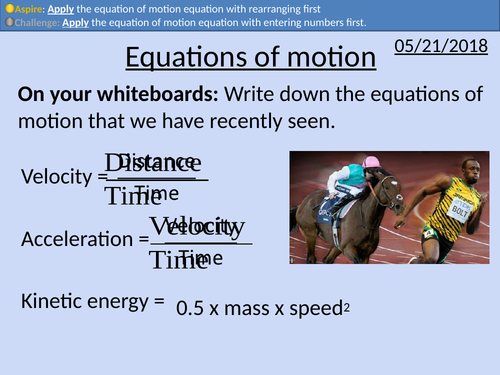497Uploads
167k+Views
71k+Downloads
All resources

GCSE Physics: Equations of Motion
This presentation covers GCSE Physics OCR Gateway P2.1.6
Introduction of final speed^2 – initial speed^2 = 2 x acceleration x distance
Rearranging of final speed^2 – initial speed^2 = 2 x acceleration x distance
Derivation of final speed^2 – initial speed^2 = 2 x acceleration x distance
Three different methods for rearranging equations
Kinetic energy, acceleration and speed problems with answers

OCR A Level Physics: Simple Harmonic Motion and Energy
OCR A Level Physics: Energy and Simple Harmonic Motion presentation with homework and answers

GCSE Physics: Electrical Resistance
This PowerPoint presentation with worked examples and student questions covers:
• Ohm’s law and units
• Proportionalities
• Resistance in series
• Rearranging equations
• Calculating resistance with ohm’s law

OCR AS level Physics: Mean Drift Velocity
OCR AS level Physics: Mean Drift Velocity is a part of the Module 4: Electrons, Waves, and Photons.
Presentation come with worked examples, solutions and homeworks.
Number density for conductors, semi-conductors, and insulators
Calculating cross-sectional area
Apply the mean drift velocity equation.
Derivation of Mean Drift Velocity Equation

OCR AS level Physics: Current and Charge
OCR AS level Physics: Current and Charge is a part of the Module 4: Electrons, Waves, and Photons.
Presentation come with worked examples, solutions and homeworks.

GCSE Physics: The Solar System
This presentation covers OCR Gateway Physics 9-1 P8.3.2 Our Solar System
This PowerPoint is a whole lessons included with student activities and animated answers.
Structure of the solar system
Nuclear Fusion
Evolution of large stars
Evolution of Sun like stars
Gravitational force and force from nuclear fusion

OCR AS level Physics: Potential Difference and Electromotive Force
OCR AS level Physics: Potential Difference and Electromotive Force is a part of the Module 4: Electrons, Waves, and Photons.
Presentation come with worked examples, solutions and homeworks.
Calculating the base SI units for volts
Comparing potential difference and electromotive force (emf).
Circuit diagrams for measuring potential difference and emf.
Calculating energy dissipated in a circuit.

OCR AS level Physics: Derived Units
OCR AS level Physics: Derived Units is a part of the Module 2: Foundations of Physics
Full lesson PowerPoint with worked examples and homework with complete worked answers.
Indices Notation
Converting from Celsius to Kelvin.
Determining base units from derived units.

OCR AS level Physics: Power and Efficiency
OCR AS level Physics: Power and Efficiency is a part of the Module 3: Work, Energy and Power.
Presentation come with worked examples, solutions and homeworks.

OCR AS level Physics: Springs and Hooke's Law
OCR AS level Physics: Springs and Hooke’s Law is a part of the Module 3: Materials.
Presentation come with worked examples, solutions and homeworks.

OCR AS level Physics: Polarisation
OCR AS level Physics: Polarisation is a part of the Module 4: Electrons, Waves, and Photons. PowerPoint with worked examples and homework.

OCR AS level Physics: Interference
OCR AS level Physics: Interference is a part of the Module 4: Electrons, Waves, and Photons. PowerPoint with worked examples and homework.

OCR AS level Physics: Stationary Waves in Air Columns
OCR AS level Physics: Stationary Waves in Air Columns is a part of the Module 4: Electrons, Waves, and Photons. PowerPoint with worked examples and homework.

OCR AS level Physics: Harmonics
OCR AS level Physics: Harmonics is a part of the Module 4: Electrons, Waves, and Photons. PowerPoint with worked examples and homework.

OCR AS level Physics: The Photoelectric Effect
OCR AS level Physics: The Photoelectric Effect is a part of the Module 4: Electrons, Waves, and Photons.
Full lesson PowerPoint with worked examples and homework with complete worked answers.
Threshold frequency
Producing photoelectrons
Kinetic energy of photoelectrons
Linking frequency and wavelength
The electromagnetic spectrum, frequency and energy.

GCSE Chemistry: Isotopes and Ions
This PowerPoint presentation with worked examples and student questions covers:
• Definitions of elements, isotopes, and ions
• State mass number, atomic number, and chemical symbols
• Calculate the number of neutrons
Bundle

GCSE OCR Chemistry: P1.1 The Particle Model
All resources for P1.1 GCSE OCR Chemistry Gateway 9-1 Triple and combined (Higher and Foundation) is covered in this material.
Includes:
Introducing Particles
Chemical and Physical Changes
Limitations of the Particle Model

OCR Applied Science: 1.1 The Atom
This PowerPoint presentation with worked examples and student activities covers:
Topic 1.1 of Science Fundementals of the OCR Applied Science Spec.
nucleus contains protons and neutrons surrounded by electrons
relative masses and charges
nuclear and atomic diameters
nucleon number, proton number and isotopes
proton number defines the type of atom
nuclear notation
attractive and repulsive forces within the nucleus

OCR Applied Science: 2.1 Mixtures and Alloys
This PowerPoint presentation with worked examples and student activities covers:
Topic 2.1 of Science Fundementals of the OCR Applied Science Spec.
Types of mixtures to include solutions, colloids and suspensions
Difference between colloids and suspensions in terms of particle size
Uses of common colloids in nature and medicine
Types of colloids to include aerosols, emulsions, foams, gels and sols
Significance of colloids in nature and medicine
Alloys as mixtures of metals
The character and features of alloys
Uses of common alloys to include amalgam, solder, bronze, titanium alloy

GCSE Chemistry: Filtration and Crystallisation
This PowerPoint presentation with worked examples and student questions covers:
Definitions for solution, solute, solvent, insoluble, soluble.
The technique of filtration
The technique of crystallisation




















